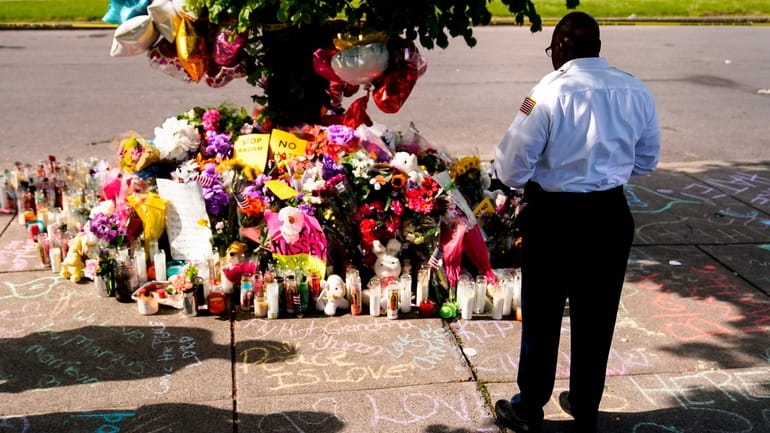Racism is real — so is multiracial America

Howard Patton pays his respects at the scene of Saturday's shooting at a supermarket, in Buffalo, Wednesday. Credit: AP/Matt Rourke
The abhorrent attack last Saturday in Buffalo has become a story in which major and pressing issues intersect: race relations, anti-immigration fear-mongering, the rise of violent extremism, and online radicalization.
Payton S. Gendron, an 18-year-old apparently obsessed with the "replacement" of white Americans, is charged with killing 10 people and wounding three in a shooting spree that deliberately targeted Blacks. His act of racial terrorism takes place during a troubled time of political polarization, cultural tensions and ugly rhetoric.
But perhaps this very dark moment can also show America the way to hope.
There are certainly reasons to feel pessimistic. Many have noted that toned-down versions of Gendron’s “replacement” rhetoric — claims that Democrats are deliberately encouraging Third World immigration in order to gain electoral advantage by “importing” voters — can be heard on Fox News, particularly on Tucker Carlson’s popular program, and from prominent Republican politicians including upstate congresswoman Elise Stefanik. “Great Replacement” conspiracy theory has already been linked to several other racial attacks, including the 2019 shooting in El Paso, Texas, that targeted Hispanics and left 23 dead and as many wounded.
While there’s no evidence that Gendron got his ideas from mainstream sources — he appears to have been radicalized by extremist pockets of the Internet — such rhetoric still has a toxic effect on the cultural climate. Whether its peddlers will moderate the ugly fearmongering remains to be seen; so far, they seem to be engaging in a lot of self-exculpatory spin.
In response to the massacre, some progressive voices have invoked a vision of an America steeped in white supremacy and backsliding. A few have groundlessly suggested that the leaked Supreme Court draft overturning abortion rights reflects racist fears about low white birth rates. Some have invoked the acquittal of Kyle Rittenhouse, the teenager who killed two men during a riot stemming from a 2020 Black Lives Matter protest in Kenosha, Wisconsin, as a supposed parallel to the Buffalo shooting.
This is a left-wing version of fearmongering, also toxic in its own way.
President Biden in his remarks Tuesday in Buffalo struck the right note. He did not sugarcoat the problems, stressing that white supremacist hate is a poison that has been allowed to fester too long. But he also invoked old-fashioned American patriotism, declaring that “we are the most multiracial, most dynamic nation in the history of the world” and that “these hate-filled attacks represent the views of a hate-filled minority.” He affirmed that “the idea of our nation [is] that we’re all children of God” and that “the ideology of white supremacy has no place in America.”
This hopeful message doesn’t negate the reality of white supremacy in American history. But it always existed in conflict with the principle that “all men are created equal.” The belief that this principle should extend to nonwhites — once a radical minority view — is now embraced by the vast majority.
Obviously, racial hate still exists, and it can be more complex than white supremacy; the past week has seen hate-motivated shootings in which both the suspects and the victims are nonwhite. But the America of which President Biden speaks, a multiracial country that can come together against hate, is also real. Whether it’s the America of the future is up to us.
Opinions expressed by Cathy Young, a senior fellow at the Cato Institute, are her own.

